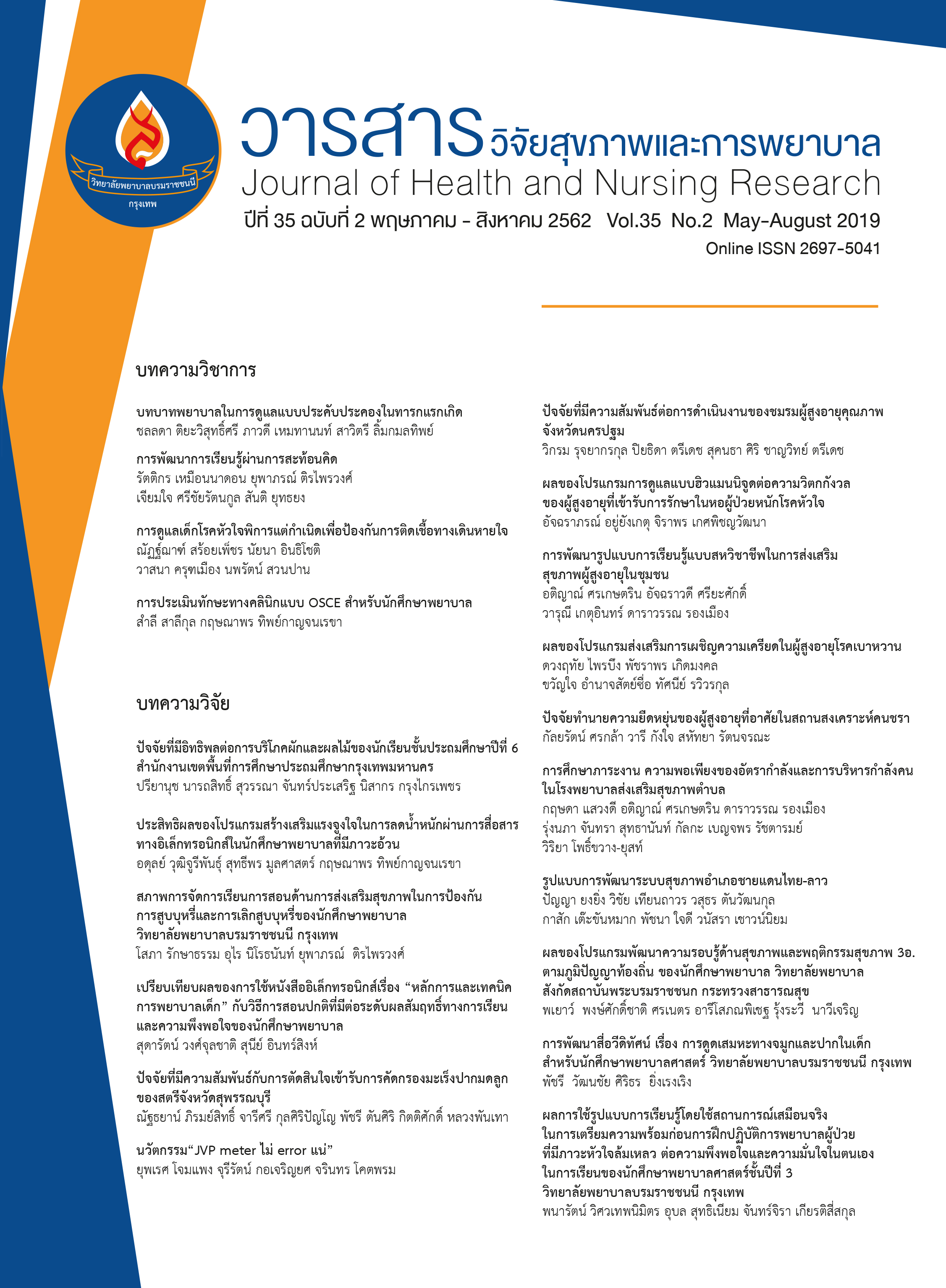ผลของโปรแกรมการดูแลแบบฮิวแมนนิจูดต่อความวิตกกังวลของผู้สูงอายุ ที่เข้ารับการรักษาในหอผู้ป่วยหนักโรคหัวใจ
บทคัดย่อ
การวิจัยกึ่งทดลองนี้ มีวัตถุประสงค์เพื่อเปรียบเทียบความวิตกกังวลของผู้สูงอายุที่เข้ารับการรักษาในหอผู้ป่วยหนักโรคหัวใจก่อนและหลังได้รับโปรแกรมการดูแลแบบฮิวแมนนิจูด และเพื่อเปรียบเทียบความ วิตกกังวลของผู้สูงอายุที่เข้ารับการรักษาในหอผู้ป่วยหนักโรคหัวใจระหว่างกลุ่มที่ได้รับโปรแกรมการดูแลแบบฮิวแมนนิจูดกับกลุ่มที่ได้รับการพยาบาลตามปกติ กลุ่มตัวอย่าง คือ ผู้สูงอายุที่มีอายุ 60 ปีบริบูรณ์ขึ้นไป ทั้งเพศชายและเพศหญิง ที่เข้ารับการรักษาในหอผู้ป่วยหนักโรคหัวใจ โรงพยาบาลราชวิถี โดยมีความวิตกกังวลขณะเผชิญอยู่ในระดับปานกลาง จำนวน 44 คน แบ่งเป็นกลุ่มควบคุมและกลุ่มทดลอง กลุ่มละ 22 คน กลุ่มควบคุมได้รับการพยาบาลตามปกติ ในขณะที่กลุ่มทดลองได้รับโปรแกรมการดูแลแบบฮิวแมนนิจูดเป็นระยะเวลา 3 วัน วันละ 1 ครั้ง ครั้งละ 20-30 นาที เครื่องมือที่ใช้ในการวิจัย ได้แก่ โปรแกรมการดูแลแบบ ฮิวแมนนิจูด เก็บรวบรวมข้อมูลโดยใช้แบบประเมินความวิตกกังวลขณะเผชิญ (The State Anxiety Inventory; Form X-1) ผ่านการตรวจสอบความเหมาะสมและความตรงตามเนื้อหาจากผู้ทรงคุณวุฒิ 5 ท่าน มีค่าความเที่ยงเท่ากับ 0.89 วิเคราะห์ข้อมูลด้วยสถิติเชิงพรรณนา และสถิติทดสอบค่าที
ผลการวิจัยพบว่า
- 1. ค่าเฉลี่ยคะแนนความวิตกกังวลของผู้สูงอายุที่เข้ารับการรักษาในหอผู้ป่วยหนักโรคหัวใจหลังได้รับโปรแกรมการดูแลแบบฮิวแมนนิจูดต่ำกว่าก่อนได้รับโปรแกรมอย่างมีนัยสำคัญทางสถิติ (P<.05)
- 2. ค่าเฉลี่ยคะแนนความวิตกกังวลของผู้สูงอายุที่เข้ารับการรักษาในหอผู้ป่วยหนักโรคหัวใจกลุ่มที่ได้รับโปรแกรมการดูแลแบบฮิวแมนนิจูดต่ำกว่ากลุ่มที่ได้รับการพยาบาลแบบปกติอย่างมีนัยสำคัญทางสถิติ (P<.05)
ผลการศึกษาในครั้งนี้แสดงให้เห็นว่าโปรแกรมการดูแลแบบฮิวแมนนิจูดสามารถลดความวิตกกังวลของผู้สูงอายุที่เข้ารับการรักษาในหอผู้ป่วยหนักโรคหัวใจได้
Downloads
เอกสารอ้างอิง
2. Kosolchuenvijit J. Caring: Central focus of humanistic care. Journal of Boromarajonani College of Nursing, Bangkok 2013;29:134-41. (in Thai)
3. Chang CW, Chen YM, Su CC. Care needs of older patients in the intensive care units. Journal of Clinical Nursing 2012;21:825-32.
4. Han KS, Park YI. The level of anxiety and relating factors of ICU patients. The Journal of Korean Academic Society of Nursing Education 2002;8:155-66.
5. Hanucharurnkun S. Nursing: the science of practice. 2nd ed. Bangkok: V J printing; 2011. (in Thai)
6. Tullmann DF, Hawkes PB, Enfield EH. The critical care environment. In: Foreman MD, Milisen K, Fulmer TT, editors. Critical Care Nursing of the Older Adult: Best Practices. New York: Springer Publishing Company; 2010. p. 23-35.
7. Moser DK, Chung ML, Mckinley S, Regel B, An K, Cherington CC. Critical care nursing practice regarding patient anxiety assessment management. Intensive and Critical Care Nursing 2003;19:276-88.
8. Eliopoulos C. Gerontological ursing. 8th ed. Philadelphia: Wolters Kluwer Health/ Lippincott Williams & Wilkins; 2014.
9. Koh CK. Patients' anxiety in intensive care units and its related factors. Taehan Kanho Hakhoe Chi 2007;37:586-93.
10. Balasubramanian N. A study to assess level of anxiety among intensive care unit (ICU), patients in a selected hospital, Salem, Tamilnadu. Asian Journal of Nursing Education and Research 2013;3:88-92.
11. An K, De Jong MJ, Riegel BJ, McKinley S, Garvin BJ, Doering LV, et al. A cross-sectional examination of changes in anxiety early after acute myocardial infarction. The Journal of Acute and Critical Care 2004;33:75-82.
12. Spielberger CD, Guerrero RD. Cross-Cultural Anxiety. New York: Hemisphere Publishing Corporation; 1983.
13. Hildrum B, Mykletun A, Holmen J, Dahl AA. Effect of anxiety and depression on blood pressure: 11-year longitudinal population study. The British Journal of Psychiatry 2008;193:108-13.
14. Cherrington CC, Moser DK, Lennie TA, Kennedy CW. Illness representation after acute myocardial infarction: impact on in-hospital recovery. American Journal of Critical Care 2004;13:136-45.
15. Gineste Y, Marescotti R. The sensory capture and feedback in the management of behavioural disturbances in demented old patients during basic care [Internet]. 2008 [cited 2015 Oct 1]. Available from: http://cec-formation. net. pagespersoorange.fr/sensorycapture.htm.
16. Phaneuf M. The concept of humanitude as applied to general nursing care [Internet]. 2007 [cited 2016 Sep 1]. Available from: http://www.infiressources. ca/fer/ Depotdocument_anglais /The_concept_ of_humanitude_ as_applied_ to_general_nursing_care.pdf.
17. Ito M, Honda M, Gineste Y, Marescott R, Hirayama R, Shimada C, et al. An examination of the influence of Humanitude caregiving on the behavior of older adults with dementia in Japan. [Internet]. 2015[cited 2016, Sep 17]. Available from: http://humanitude-usa.com/wpcontent/uploads/ 2015/11/
Diapositive1.pdf.
18. Burns N, Grove SK. The practice of nursing research: Appraisal. Synthesis and Generation of Evidence. 6th ed. St Louis: Saunders Elsevier; 2009.
19. Detyoddee P. The effect of transitional information on anxiety reduction in patients with acute coronary syndrome discharging form intensive care. [Master’s thesis of Nursing Science]. Khon Kaen: Khon Kaen University; 2007. (in Thai)
20. Honda M, Mori M, Hayashi S, Moriya K, Marescotti R, Gineste Y. The effectiveness of French origin dementia care method; Humanitude to acute care hospitals in Japan. European Geriatric Medicine 2013:s207.
ดาวน์โหลด
เผยแพร่แล้ว
รูปแบบการอ้างอิง
ฉบับ
ประเภทบทความ
สัญญาอนุญาต
บทความที่ได้รับการตีพิมพ์ เป็นลิขสิทธิ์ของวารสารวิจัยสุขภาพและการพยาบาล (วิทยาลัยพยาบาลบรมราชชนนี กรุงเทพ) ไม่สามารถนำไปตีพิมพ์ซ้ำในวารสารฉบับอื่น


















